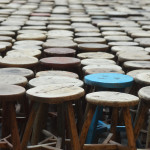Travel notes from Cuzco, Peru
6/15/09
Ancient stone walls and slick cobblestones, crumbling adobe and majestic indigenous women wrapped in fabric rainbows. Swarming tourists, razor thin air. Been fighting off altitude sickness, up the first night vomiting, dry heaving. Aurora the second night. We’ve been half-bedridden, only venturing out for coffee here and there, to watch the processions in the Plaza de Armas. It is impossible to catch your breath or feel truly warm.
I’ve been feeling insecure in thought and purpose here. When faced with such poverty, is there something obscene about enjoying oneself? The juxtaposition of the townsfolk and the tourists is harsh. Sitting in the plaza, I am approached by vendors again and again. I’ve been reading The Monkey’s Paw, New Chronicles from Peru by Robin Kirk. Even as it puts the violent events of Peru’s recent past into some perspective, humanizing its subject, the gallery of atrocities it describes are dizzying. I found myself missing San Francisco, feeling trapped far from home.
We went walking again, had some dinner. Cuzco’s beauty and charm are undeniable. Narrow streets, old balconies. The air redolent with fine food cooking. The sounds of drums, pipes, horns, voices, coming from odd unexpected angles, disguised, masked by the wind. A feeling of a deep and mysterious history, shame and dignity mixed. Pride of culture. In the deepening twilight, taxis bumble up the cobblestones. Church bells toll. Then it is not a feeling of regret I have of being in this place, but a yearning to find a way into it. To feel that I am something more than the tourist machine, consuming sights, sounds, and tastes as part of a consumer object. How to get past the tourist/traveler veil is a difficult thing in a place like Cuzco, which processes thousands of tourists through it every month. It reminds me of Antigua, in Guatemala, in this sense.
In Lima, I feel no sense of guilt. In the cities, I’m never afraid of hurting what I touch. But here, where women in traditional clothing and an alpaca and small child in tow go around trying to charge tourists for a picture, you see that the phenomenon of charging money for a spectacle has permeated deep into the environment, and this combined with poverty creates a noxious atmosphere.
Despite all this, I feel lucky to have seen Cuzco. Even after seeing indigenous highlands in Mexico and Guatemala, which have many parallels with here, Cuzco is distinctive, unique, visually arresting.
6/15/09
Moray
A giant amphitheatre between hills, terraces following the shape of the hills until the terraces become perfect circles. Stone walls bolster the terraces, Inca stone.
6/16/09
I’m finally acclimatized to Cuzco. The air is delicate and the sunlight sharp and I feel great. We’re at Cafe Punchay on Choquecacha. Table at an open porch, engulfed by flowers adjacent to the table. Food and coffee served in red pottery. Daisies, or some kind of chrysanthemum.
A large decrepit trumpet vine leans towards stairs climbing to a narrow balcony above us, running the length of the building, which is a 2-story adobe roofed with corrugated metal. A rust-colored antenna lashed to the rain gutter with wire teeters into the insane blue sky. The underside of the staircase looks like cardboard.
A man sits wearing mirrored sunglasses reading. A fence leans into a rosebush. A car alarm squeals, a baby cries. A black plastic bag floats in the soft mountain breeze like a jellyfish. Grass is coming up through the tile on the patio. Taxis roll by. The sun is melting the butter in the dish.
6/16
Yesterday at Ollantaytambo I saw a blind harp player and I sat and listened and it was the deepest I’ve felt music in a long time. The harp player sang sad songs in a high ragged voice cracked with pain and memory and lost youth, his fingers spidering across the strings with an ease beyond thought.
A boy sat nearby watching him, the harp player’s son or grandchild. The boy helped the sightless man, the blanket around his shoulders. The dry wind swept down off the Inca ruins, the ancient smooth polished stones, stirring the rows of trinkets for sale, the bone windchimes.







